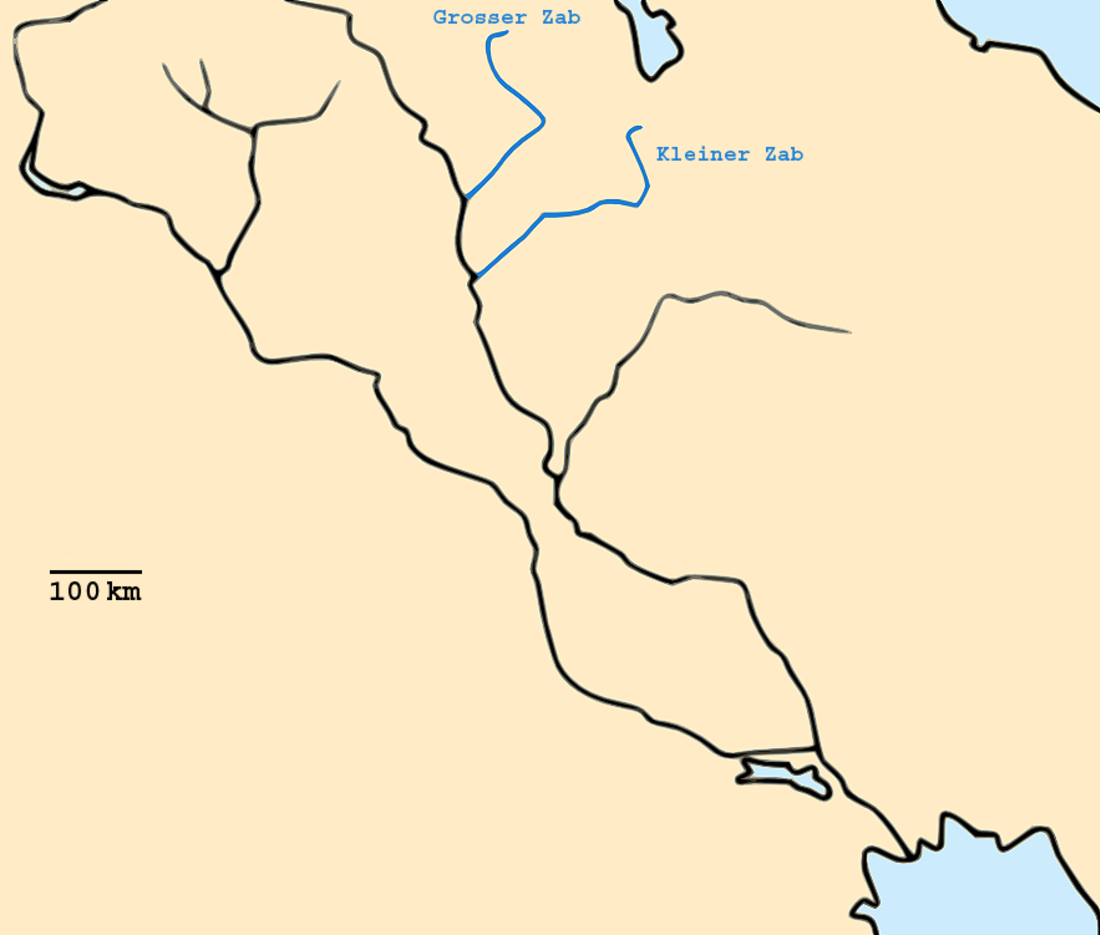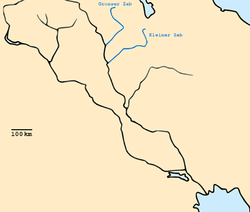Top Qs
Timeline
Chat
Perspective
Battle of the Zab
Part of the Abbasid Revolution, 750 AD From Wikipedia, the free encyclopedia
Remove ads
The Battle of the Zab (Arabic: معركة الزاب), also referred to in scholarly contexts as Battle of the Great Zāb River, took place on January 25, 750, on the banks of the Great Zab[6] in what is now the modern country of Iraq. It spelled the end of the Umayyad Caliphate and the rise of the Abbasid Caliphate, which would last from 750 to 1258.
This article has multiple issues. Please help improve it or discuss these issues on the talk page. (Learn how and when to remove these messages)
|
Remove ads
Background
Summarize
Perspective
During the leadership of Muhammad ibn Ali and his son Ibrahim, the Abbasids in Iraq and Khorasan, who had previously accepted their call, became increasingly active against the Umayyads. The Abbasids recognized Iran, particularly Khorasan, as a favorable region for religious-political da'wah.[7] This eastern province was distant from the Umayyad capital, had limited Arab influence, and was home to other religious movements with political elements. Umayyad authority weakened further when the caliph intervened in conflicts between the Qays and the Yaman.
In 128 AH (745–746 CE), during the governorship of Nasr ibn Sayyar, Ibrahim sent the Abbasid da'wah leader, Abu Muslim, to Khorasan.[8] Abu Muslim initially conducted his mission in secret but publicly proclaimed it in 129 AH (May–June 747) at the house of Sulayman ibn Kathir in the village of Safidhanj near Merv. His followers carried the Black Standard, symbolizing their opposition to the Umayyads.[9] Many local inhabitants joined him, significantly increasing his support. Nasr ibn Sayyar sent forces against Abu Muslim, who defeated them, establishing his reputation. Abu Muslim then consolidated control over several key cities, including Herat, Balkh, Abiward, before capturing Merv in February.[10]
Abu Muslim subsequently dispatched his general Qahtaba ibn Shabib with an army to Persia and Iraq. Qahtaba captured Nishapur, and after defeating the Umayyad relief forces, advanced into Iraq. Following a series of victories in Ray, Hamadan, and Isfahan, Qahtaba's forces compelled local Umayyad garrisons to surrender. A subordinate, Abu Awn Abd al-Malik ibn Yazid, successfully defeated Abdullah ibn Marwan in northern Iraq. Qahtaba was killed on 8 Muharram 132 AH (27 August 749), and his son Hasan assumed command, entering Kufa, where local leaders raised the Abbasid banner.
Meanwhile, Ibrahim ibn Muhammad, the head of the Abbasid da'wah, died in prison in Harran, reportedly due to an epidemic.[11] The surviving Abbasids, including Al-Saffah and Al-Mansur, were hidden in Kufa until the Khorasani leaders found them and proclaimed Abu al-Abbas al-Saffah as the new caliph in the mosque at Kufa.[12] With this, Abbasid forces had secured their position in Iraq, setting the stage for the confrontation with the Umayyads at the Battle of the Zab.
Remove ads
Armies
In 750, the army of the Umayyad caliph Marwan II fought a combined force of Abbasid, Shia, Khawarij, and Iraqi forces. Marwan's army was, on paper at least, far larger and more formidable than that of his opponents, as it contained many veterans of earlier Umayyad campaigns against the Byzantine Empire; its support for the caliph, however, was only lukewarm. The morale of the Umayyads had been damaged by the series of defeats inflicted earlier in the rebellion, while the morale of the Abbasid armies had increased.[13]
Remove ads
Battle
The Abbasid army formed a spear wall, a tactic they had adopted from their Umayyad opponents, presumably from witnessing it in earlier battles. This entailed standing in a battle line with their lances pointed at the enemy (similar to the stakes used by English longbowmen at Agincourt and Crécy many centuries later). The Umayyad cavalry charged, possibly believing that with their experience they could break the spear wall. This was a mistake on their part, however, and they were all but butchered. The Umayyad army fell into retreat, its morale finally shattered. Many were cut down by the zealous Abbasids or were drowned in the wintertime River Zab.[14][15]
Aftermath
Marwan II fled at last to Abusir a small town in the Egyptian Nile Delta. There, a few months after the battle, he was found hiding in a church by a small Abbasid detachment under the command of Abu Awn. He was overpowered and slain. His head was sent to the commander Salih ibn Ali Uncle of Al-Saffah, who had the tongue cut out and thrown to a cat in contempt. The disfigured head was then delivered to Al-Saffah (r. 750–754), who bowed in thanks to God, recited a verse of vengeance, and assumed the caliphate—bringing Umayyad rule in the Middle East to an end.[16][17]
Remove ads
See also
- Battle of Talas was a military engagement between the Abbasid Caliphate against the Chinese Tang dynasty in July 751 AD.
References
Further reading
Wikiwand - on
Seamless Wikipedia browsing. On steroids.
Remove ads

